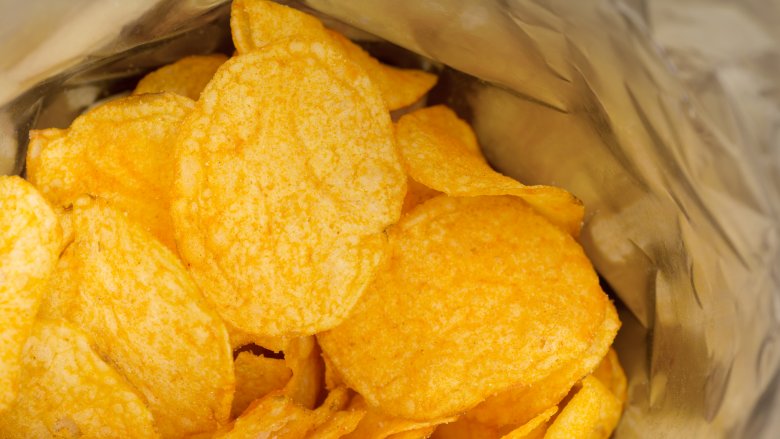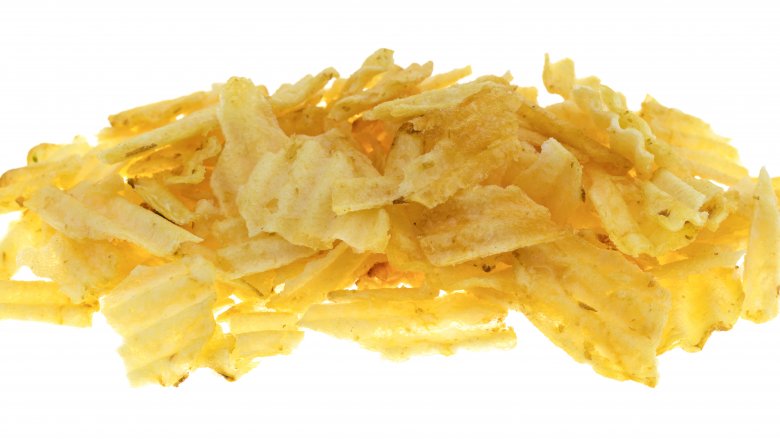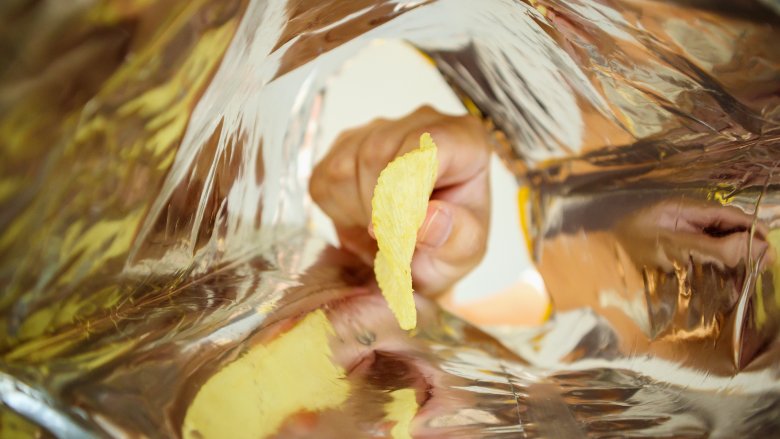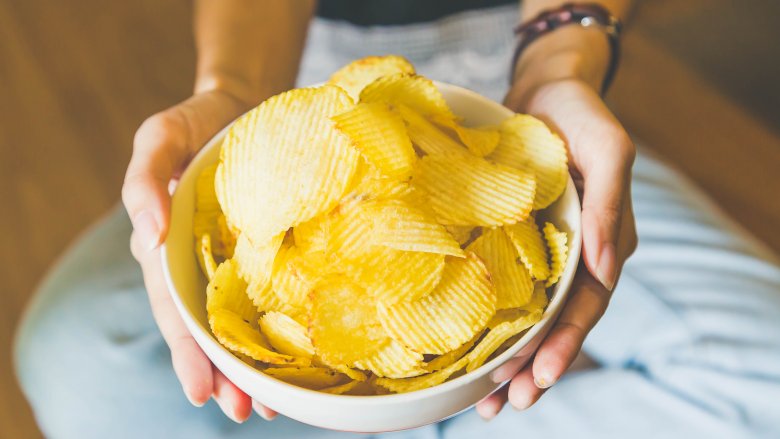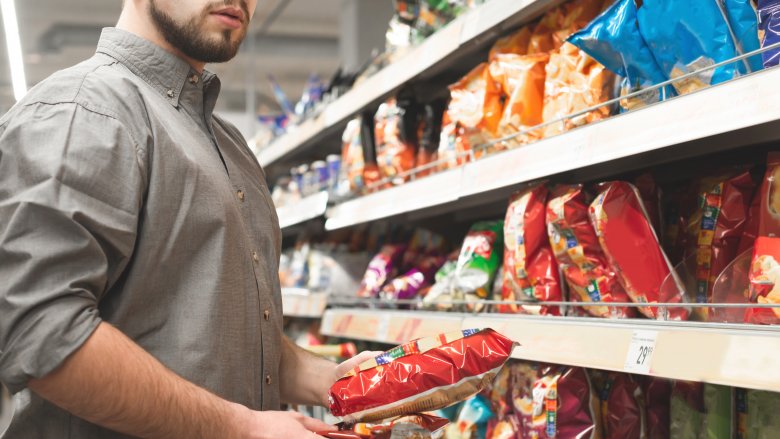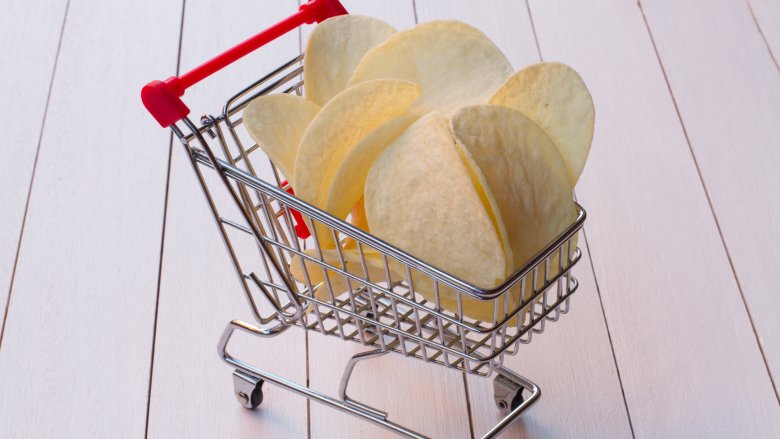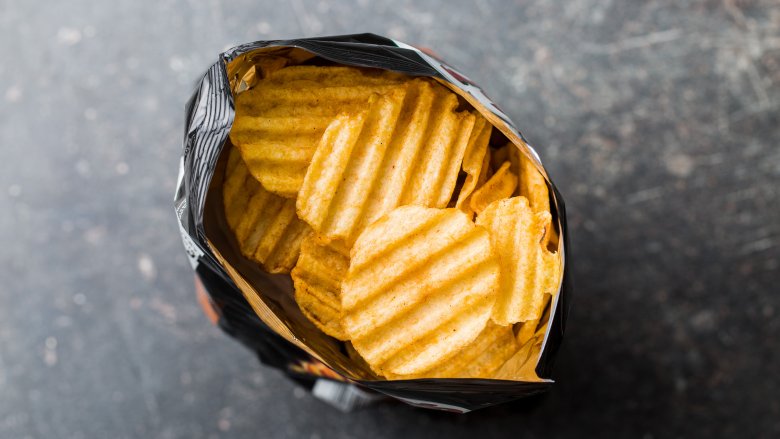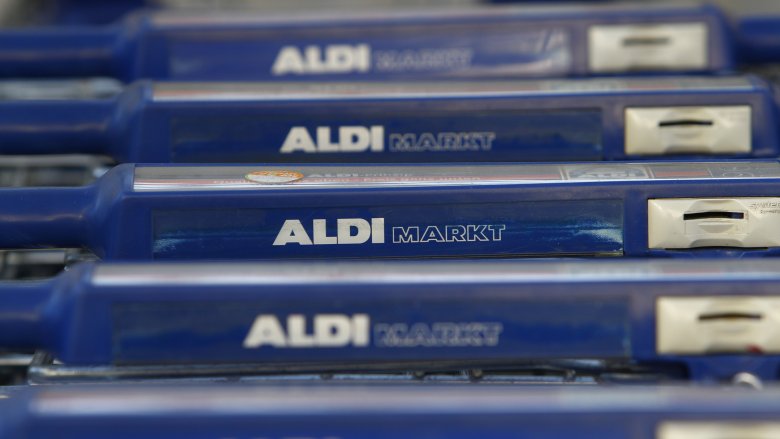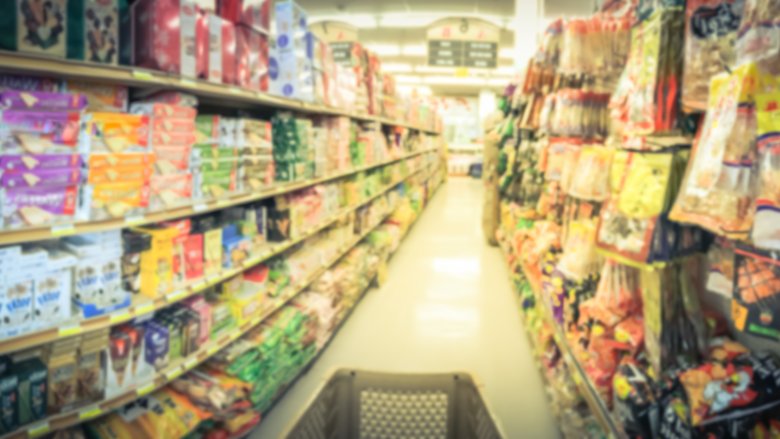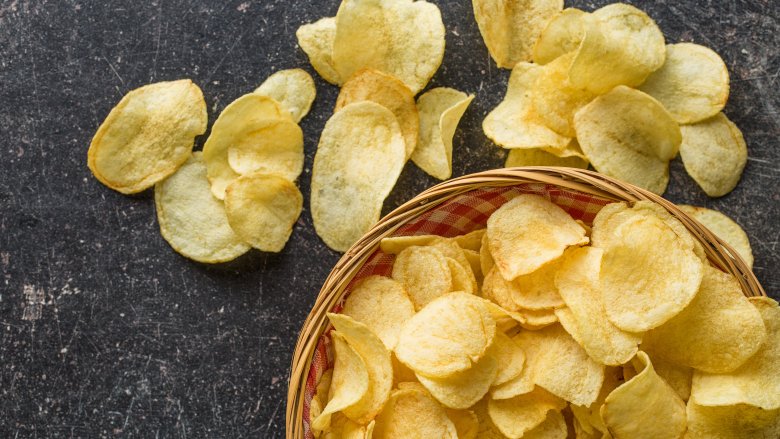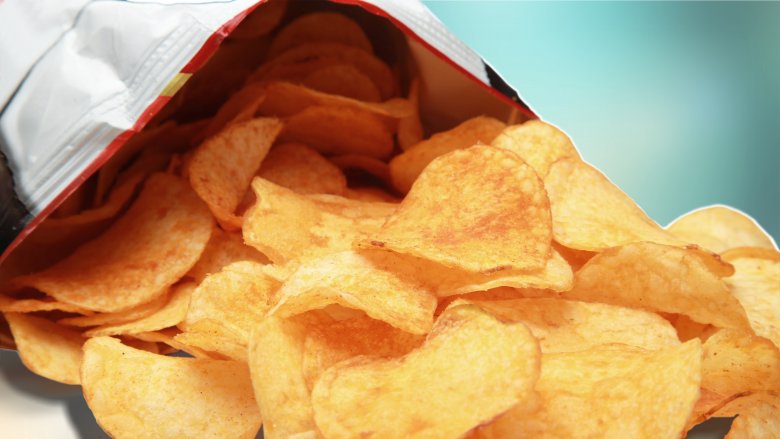The Real Reason Your Potato Chip Bag Is Half Empty
We've all been there. We pick up a bag of our favorite kind of chips, hit the couch, and tear into them. That giant bag you were going to split with your other half? You see it's only about half full, and you start to wonder whether or not it's time you gave the single life a try.
And it's not just chips, either. It's the same story with a box of cereal, a package of cookies, a bag of granola... so, what gives? Are companies trying to fool us into thinking we're getting more than we actually are? Sometimes... maybe?
But more often, there's a very good reason for what's called "slack fill", and it actually serves more than one important purpose. Who would have thought that extra, rage-inducing empty space is the reason why you can actually enjoy those chips, disappointment-free, when you turn on Netflix? Let's talk about a little bit of science, peppered with a little bit of legalese, and find out just how much you're paying for all that empty space.
It keeps you from getting chip crumbles
First, let's confirm that the reason you might guess there's all that empty space is, indeed, one of the reasons. According to Mental Floss, one of the biggest reasons manufacturers add slack fill to their packages, particularly when it comes to delicate foods like potato chips, is to prevent breakage, smashage, and crumbles. The process of getting them from the manufacturer to your couch is a long one, where they're jostled around on trucks, crammed into boxes and onto shelves, and — if most delivery and trucking services are anything to judge by — they're probably delivered to at least one stopping point along the way by drop-kick.
And that empty space helps to cushion your delicate chips during all the chaos of moving. If it wasn't there, chances are pretty good you'd open that bag to find not so many chips, but just the remnants of chips. Sure, you could eat them with a spoon, but you'd be even more mad about a bag full of crumbs, wouldn't you?
No, it's not just air
All that empty space might seem like manufacturers are taking the easy way out, but it's not as simple as just filling a bag halfway and then sealing it. If they just did that, the bag would be filled with what you might think it's filled with: air. But according to Bakery and Snacks, air would be the absolute worst thing to use. Regular, normal, standard, plain old air would actually be a disservice to the chips, and anything that contains oil? Forget about it — you'd open the package to a rancid stink.
Instead, companies use nitrogen gas to fill that space. That's true whether you're talking about that bag of potato chips or even, says the American Herbal Products Association, a plastic bottle of supplements and vitamins.
And don't worry, it's perfectly safe — the air we breathe is about 78 percent nitrogen. But here's the weird thing: Popular Mechanics looked at the different things that happen when you fill tires with nitrogen instead of air, and it's safe to say some of those things extend to food, too. Nitrogen is more stable than oxygen, and it doesn't react to temperature changes like oxygen does. That's good — and it means the Fritos made in Arizona can get shipped to you in Maine and end the journey in the same condition they were in when they left.
It keeps your chips crispy and prolongs shelf life and freshness
If you've ever made potato chips at home, you know how fast they lose that crispy crunch that every good chip should have. It might even make you wonder what kind of incredible technology chip manufacturers have at their disposal to keep their chips crispy for so long. Wizardry? Almost.
Slack fill helps here, too. According to On Site Gas, injecting that bag with nitrogen does a few things. First, it gets rid of all the moisture that air has in it, and that's going to prevent the chip from absorbing that moisture and becoming soggy. It's been proven, too: Packaging Technology and Science published the results of a study (via Wiley) that found a panel of taste testers confirmed that chips packaged with nitrogen held up better and just downright tasted better.
It has a second purpose, too. Bacteria doesn't just thrive on oxygen, it needs it to grow at all. When nitrogen pushes out all the oxygen, it essentially prevents bacteria from growing, and it stops all the mold and mildew, too. That prolongs the shelf life — a lot — and it means you're not going to be opening a bag to find a small forest of moldy chips. See? Wizardry.
Just how much nitrogen is in there?
So, you might say your potato chip bag is only half full of chips, but is it really? Or are you exaggerating a bit? Kitchen Cabinet Kings actually went ahead and did the science to find out. They took some of the most popular brands of chips and looked at just what percentage of the bag's contents were chips and how much was nitrogen.
And it turns out that in some cases, you're absolutely correct. Ruffles potato chips and Stacy's Pita Chips were exactly 50 percent nitrogen and 50 percent chips. Terra chips were just behind at 49 percent nitrogen, followed by Doritos (48 percent), Kettle (47 percent), Cape Cod (46 percent), Popchips (45 percent), then Sun Chips and Lay's (41 percent).
Surprisingly, the even found one brand that was more than half nitrogen: Cheetos, which contain 59 percent empty space in their bags.
The most "honest"? Fritos, with only 19 percent nitrogen, and Pringles, with just 28 percent nitrogen. Hey, Pringles, maybe you can share your packaging technology with everyone else?
Are you paying for that empty space?
Here's a question: Are you paying for all that nitrogen (which, remember, is 78 percent of what we breathe every day) and all that chip-free space? You betcha.
Kitchen Cabinet Kings took a look at the comparison between the price you pay for a bag of chips when you go to the store and just how much only the chips you get cost. The results are pretty eye-opening, and just might encourage you to start making your own.
Let's take Lay's Baked line of chips. You're going to pay about $3 for the bag, which is 61 percent filled with chips. The price of the chips alone? $1.83.
They're not alone, either. Stacy's Pita Chips cost around $2.99, and they're exactly half full of chips: chips that, on their own, cost half that price: $1.50.
How about Sun Chips? One bag of those is going to set you back around $3, and you'll get a bag that's 59 percent full. The price if you paid for just the chips? $1.77.
What about the environmental impact?
You're definitely not the only one who's outraged by this bag-half-empty phenomenon. According to BBC, the UK crisp manufacturer Walkers got some serious hate from consumers who were opening their bags of crisps and finding just five actual crisps. That's insane!
The phenomenon inspired the artist Henry Hargreaves to do his own investigations to find out what was going on, and he had this to say about it: "Packaging and the display of food has become an illusion and a fantasy."
He found there were some bags he opened that had as much as 87 percent empty space, and even he was shocked — and he went into it with a cynical eye. He went on to do some figuring, and says he found that if you take Doritos alone, 86 out of every 100 Doritos delivery trucks wouldn't have to be used if there was just less empty space in the bags. At a time when the world around us is reaching an environmental tipping point, that's a huge deal.
Aldi doesn't believe in the process
Do you love Aldi? Who doesn't?
Next time you're there — or next time you pick up any of their private label brand chips — take a look at how big the package is and how much empty space they include. It's nowhere near the 59 percent empty space of a Cheetos bag, is it?
That's because they design their product to have a minimum amount of slack fill. The Guardian says that because they're super focused on efficiency and keeping their prices down, they opt for their own private label products over name brands in part because they can keep their packages smaller, which means fewer trucks are needed and less space is taken up by the product once it gets to the stores.
But doesn't that mean Aldi chips are going to be broken? Nope. According to Henry Hargreaves and his experiments (via BBC), too much empty space can actually cause more breakage. The most efficient way to do it, he says, is by vacuum-sealing the product and sending it on its way like that.
There's functional and non-functional slack-fill
If all this seems very concerning, don't worry — there is someone watching your back. Laws about slack fill are part of the Federal Food, Drug, and Cosmetic Act, says Nutrition Industry Executive, and it lays out the difference between "functional" and "non-functional" slack fill.
Essentially, in order to be legitimate, slack fill has to meet at least one of these criteria: It has to protect the package contents, be a consequence of a mechanized part of the packaging process, happen as a consequence of settling during transportation, perform a specific function in the prep or use of the product, be in a reusable container where that container is a part of the reason for purchase (think of a gift set), or be there to allow room for anti-tampering devices.
Otherwise, it's called "non-functional" slack fill, and that's where companies start getting into the territory of deception and making customers think they're buying more than they actually are... but only if the actual quantity isn't marked somewhere on the package. Since most products do put their contents and quantity right on the label, it's an issue that's typically not enforced by the FDA.
Yes, there have been lawsuits
If you've ever wondered why manufacturers can get away with this, it's easy: It's tough to prove that slack fill is both non-functional and deceptive.
According to Food Navigator, there were 30 slack fill lawsuits filed in 2015, 37 in 2016, and 14 in just the first half of 2017. But they also say that winning one is tough. For example, one case was tossed out of court simply because there was absolutely no deception as the quantity (of tablets) was printed clearly on the bottle, while another was thrown out because the plaintiff couldn't prove the slack fill was non-functional.
And it's not always super obvious. A case was brought again Just Born and Mike & Ike for boxes that contain an amount of slack fill perceived as higher than normal — even though the contents were clearly labeled. The reason for the space? Both so you get that distinctive rattle when you shake it, and so it's easy to open the box by pushing your thumb through the side.
Law firms haven't gotten discouraged, and according to Patterson Belknap, there's still slack fill cases being filed pretty regularly. That doesn't mean they win, though, because of one big factor: Customers, they say, aren't that stupid. It's not really that misleading after all, is it?
NASA says they can explode
Here's a fun bit of trivia for you that you can absolutely pull out at the next party you're at where there are potato chips on the table. (Or not, we're not here to judge what kind of parties you go to.)
According to Reader's Digest, NASA has taken bags of potato chips on board super-modified jets. Why? Because they can, presumably. But they did find out that when the bags were exposed to the massive change in air pressure that happens during takeoff, they react so violently that they explode. There's no word on whether or not the chips survive, but hey, it's your fun fact for the day.
Fun fact number two: According to Steve Spangler Science, you can get some serious revenge on those too-big, too-full-of-nitrogen chip bags. Just eat your chips, flatten the bag, and pop it in the microwave for no more than 5 seconds. It'll miniaturize, down to a much more appropriate size for that handful of chips.
